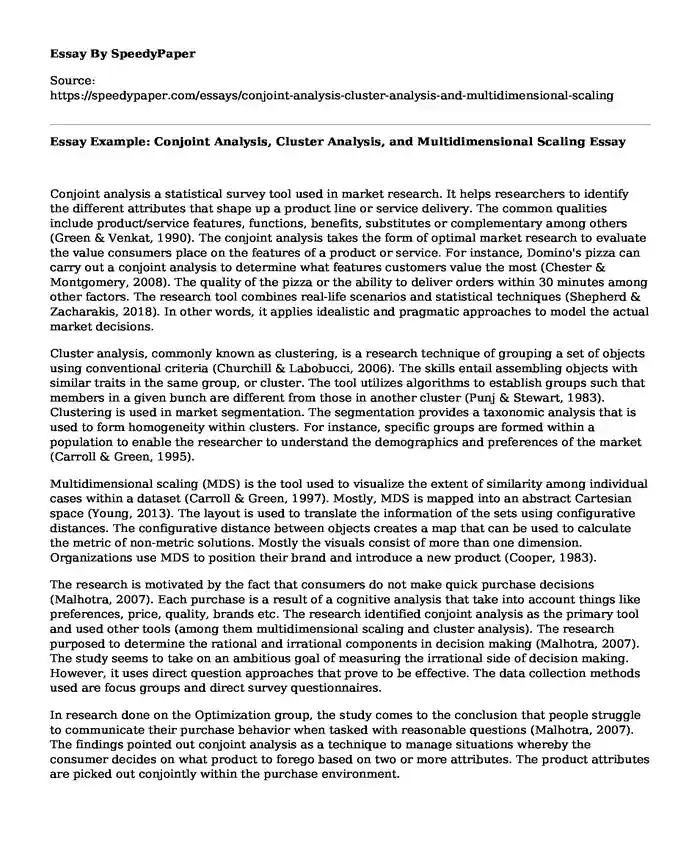
| Type of paper: | Essay |
| Categories: | Marketing Data analysis Business management |
| Pages: | 3 |
| Wordcount: | 761 words |
Conjoint analysis a statistical survey tool used in market research. It helps researchers to identify the different attributes that shape up a product line or service delivery. The common qualities include product/service features, functions, benefits, substitutes or complementary among others (Green & Venkat, 1990). The conjoint analysis takes the form of optimal market research to evaluate the value consumers place on the features of a product or service. For instance, Domino's pizza can carry out a conjoint analysis to determine what features customers value the most (Chester & Montgomery, 2008). The quality of the pizza or the ability to deliver orders within 30 minutes among other factors. The research tool combines real-life scenarios and statistical techniques (Shepherd & Zacharakis, 2018). In other words, it applies idealistic and pragmatic approaches to model the actual market decisions.
Cluster analysis, commonly known as clustering, is a research technique of grouping a set of objects using conventional criteria (Churchill & Labobucci, 2006). The skills entail assembling objects with similar traits in the same group, or cluster. The tool utilizes algorithms to establish groups such that members in a given bunch are different from those in another cluster (Punj & Stewart, 1983). Clustering is used in market segmentation. The segmentation provides a taxonomic analysis that is used to form homogeneity within clusters. For instance, specific groups are formed within a population to enable the researcher to understand the demographics and preferences of the market (Carroll & Green, 1995).
Multidimensional scaling (MDS) is the tool used to visualize the extent of similarity among individual cases within a dataset (Carroll & Green, 1997). Mostly, MDS is mapped into an abstract Cartesian space (Young, 2013). The layout is used to translate the information of the sets using configurative distances. The configurative distance between objects creates a map that can be used to calculate the metric of non-metric solutions. Mostly the visuals consist of more than one dimension. Organizations use MDS to position their brand and introduce a new product (Cooper, 1983).
The research is motivated by the fact that consumers do not make quick purchase decisions (Malhotra, 2007). Each purchase is a result of a cognitive analysis that take into account things like preferences, price, quality, brands etc. The research identified conjoint analysis as the primary tool and used other tools (among them multidimensional scaling and cluster analysis). The research purposed to determine the rational and irrational components in decision making (Malhotra, 2007). The study seems to take on an ambitious goal of measuring the irrational side of decision making. However, it uses direct question approaches that prove to be effective. The data collection methods used are focus groups and direct survey questionnaires.
In research done on the Optimization group, the study comes to the conclusion that people struggle to communicate their purchase behavior when tasked with reasonable questions (Malhotra, 2007). The findings pointed out conjoint analysis as a technique to manage situations whereby the consumer decides on what product to forego based on two or more attributes. The product attributes are picked out conjointly within the purchase environment.
The study provides a different measurement tool for understanding market preferences. Malhotra (2007) offers deliverable options for identifying segmentation and visualization of the market. Multidimensional scaling procedures were used to cut across preferences and perceptions. The visual displays represented psychological relations between stimuli and reason in s multifaceted space. Finally, Malhotra (2007) applies clustering analysis to arrange segments based on pricing, product development, brand positioning, and message optimization. These are essential features to consider while conducting a market research.
References
Carroll, J. D., & Green, P. E. (1995). Psychometric methods in marketing research: Part I, conjoint analysis. Journal of Marketing Research, 32(4), 385-391.
Carroll, J. D., & Green, P. E. (1997). Psychometric methods in marketing research: Part II, multidimensional scaling. Journal of marketing research, 34(2), 193-204.
Chester, J., & Montgomery, K. (2008). No escape: Marketing to kids in the digital age. Multinational Monitor, 29(1), 11-17.
Churchill, G. A., & Iacobucci, D. (2006). Marketing research: methodological foundations. NewYork: Dryden Press.
Cooper, L. G. (1983). A review of multidimensional scaling in marketing research. AppliedPsychological Measurement, 7(4), 427-450.
Green, Paul E., and Venkat Srinivasan. "Conjoint analysis in marketing: new developments with implications for research and practice." Journal of marketing 54.4 (1990): 3-19.
Malhotra, N. (2007). Marketing Research: an applied approach: 3rd Edition. Pearson education.
Punj, G., & Stewart, D. W. (1983). Cluster analysis in marketing research: Review and suggestions for application. Journal of marketing research, 20(2), 134-148.
Shepherd, D. A., & Zacharakis, A. (2018). Conjoint analysis: A window of opportunity for entrepreneurship research. In Reflections and Extensions on Key Papers of the First Twenty-Five Years of Advances (pp. 149-183). Emerald Publishing Limited.
Young, F. W. (2013). Multidimensional scaling: History, theory, and applications. PsychologyPress.
Cite this page
Essay Example: Conjoint Analysis, Cluster Analysis, and Multidimensional Scaling. (2022, Dec 13). Retrieved from https://speedypaper.net/essays/conjoint-analysis-cluster-analysis-and-multidimensional-scaling
Request Removal
If you are the original author of this essay and no longer wish to have it published on the SpeedyPaper website, please click below to request its removal:
- What Affects Membrane Permeability - Free Essay on the Experiment
- Essay Example: One Boy Breaks Apart Two Best Friends
- Comparing the Cultural Perspectives of Kluckholn and Hofstede, Essay Sample for You
- Organizational Behavior Assignment, Free Essay Sample for Students
- Essay Example Dedicated to Customer Feedback System
- Free Essay Example - Sexual Double Standards
- Free Paper Example on Cholesterol
Popular categories




